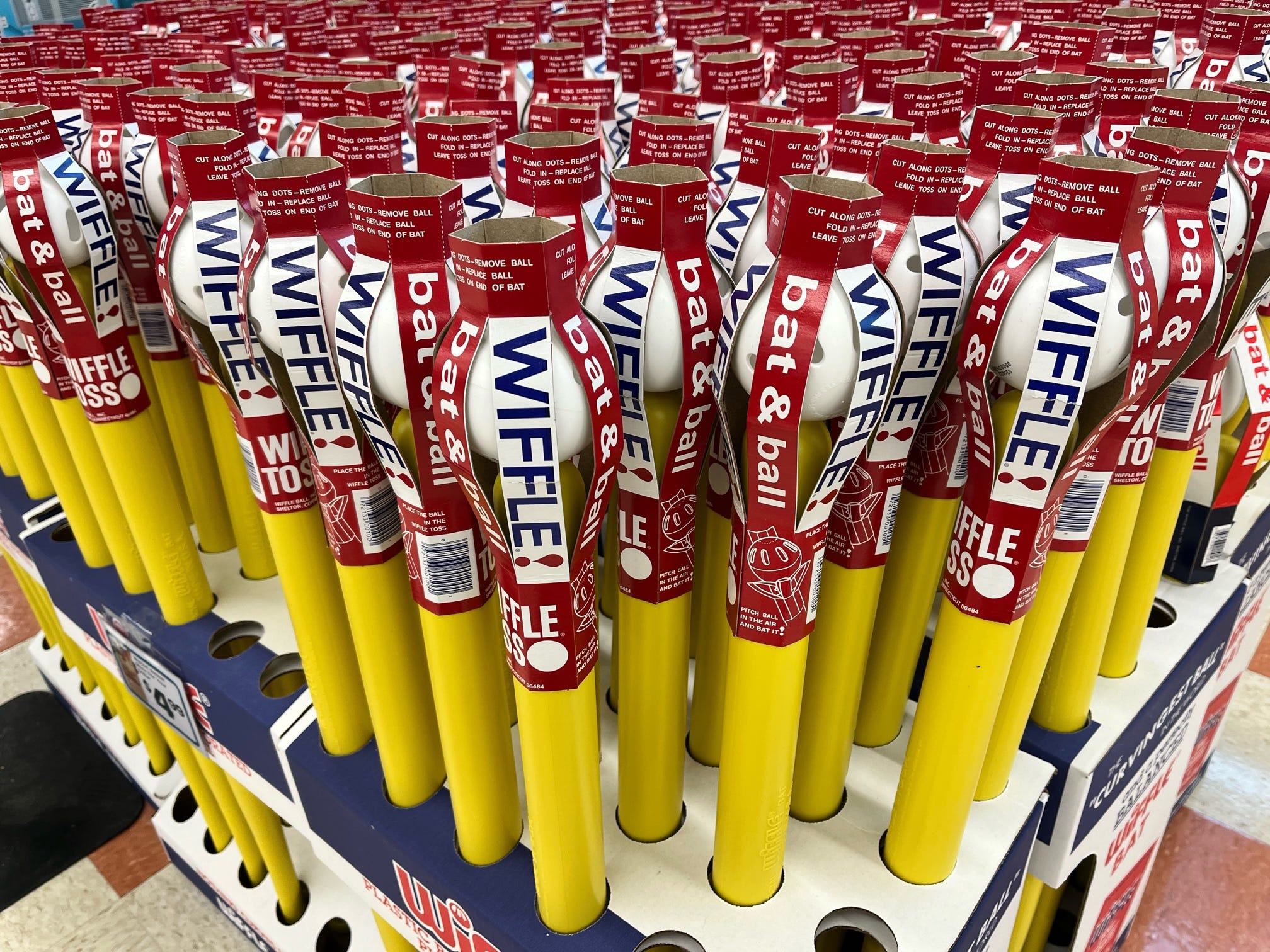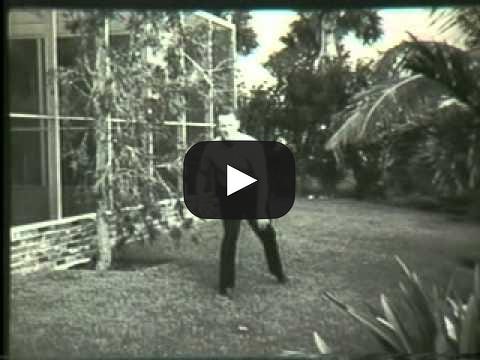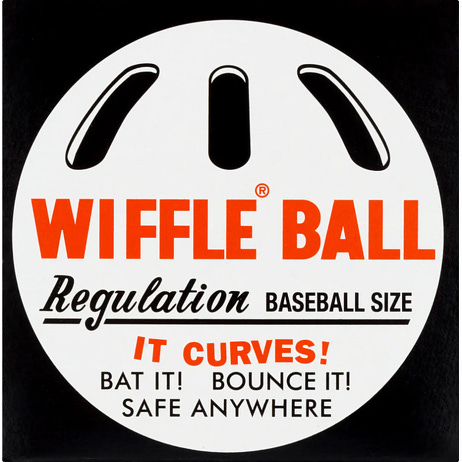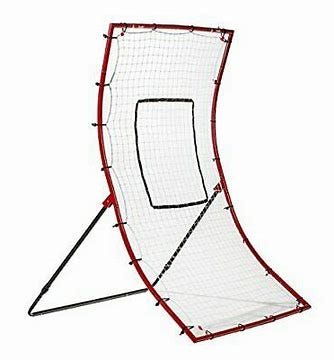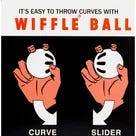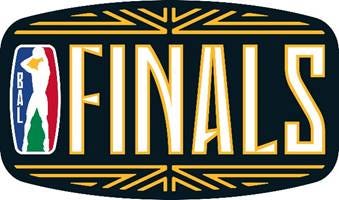Ode to the Wiffle Ball
By TERRY LYONS
BOSTON – There is a Hall of Fame toy company based at 275 Bridgeport Avenue in Shelton, Connecticut. Without a doubt, the company is responsible for keeping youngsters all across the United States of America off the streets and on their driveways or in a school yard for hundreds of thousands of hours. Yes, the Wiffle Ball, Inc. company is an American Dream, a religion, a sports industry icon and relic of our youth and the long gone days of summer.
Baseball claims to be the national pastime. Truth be told, Wiffle Ball is the REAL national pastime. Everyone has a Wiffle Ball story, a league, a tournament, a rivalry and backstory for their particular games, their field, their driveway or alleyway. There is no right or wrong, because every great Wiffle Ball player grew-up with their own big league imagination for such a great game.
Let’s delve into the nuances of the real, true, Wiffle Ball.
First the sporting equipment:
There is one and only one real Wiffle Ball. And, there is only one official hard yellow plastic Wiffle Ball bat (picture above at a display that fills grocery and sporting goods stores nation-wide. Most Wiffle Ball aficionados also prefer the Franklin Pitchback as the preferred backstop, strike zone and umpire.
The official Wiffle Ball was designed by David N. Mullany at his home in Fairfield, Connecticut in 1953 when he sought-out a ball that curved easily for his 12-year-old son. Perfectly placed oval holes on only one side of the sturdy, plastic ball did the trick. A pitcher, holding the ball upright with the holes on the right, allowed for a pretty wicked curveball. The more difficult pitch, the screwball or slider, was executed with the holes on the left. The release-point had to be perfect for the screwball, while the regular curve allowed for a more lenient release point and pitch velocity.
More advanced players enjoyed the fact a pitch could be thrown at high speeds with the holes straight down, to create a riser effect. If one were to toss the ball with the holes up, pandemonium could occur, trust me.
A seasoned Wiffle Ball pitcher can easily throw the ball at 80-90 mph, sometimes clocking in a bit higher, depending on the physics of the day. Windy days are not great for high speed, but wonderful for curves, sliders and screwballs. The Atlantic studied all sorts of physics to properly frame the perfect pitch of a Wiffle Ball. There is such a thing as a professional Wiffle Ball player and some YouTube videos depict Wiffle Ball pitching velocity up to 150 mph, a feat I have not seen by man, beast or batting range/pitching machine. A change-up can fool a batter, much the same way as in hardball.
Next, the set-up and ground rules:
Wiffle Ball games are played on open fields, in small, make-shift stadiums specifically designed for the games (some with Green Monster walls). Most often they are played on the driveways and backyards of America.
For purposes of this notebook, the explanations will come from the firsthand set-up utilized from about 1968-1983 on a Long Island-based Wiffle Ball field right on our home driveway. Some of the details will illustrate the real charm of the game.
- The Pitchback (back-stop) was set-up about two feet ahead of the driveway hoop and backboard, so to not interfere with pop-ups or any batted ball, or incredible fall-off-the-cliff, Barry Zito-like curveball.
- The pitchers mound was not a mound at all, just the end of the driveway, adjacent to the cement curb. There was no rubber to push from, so a Wiffle Ball pitcher in our neck of the woods relied solely on arm strength, good sneakers, and solid leg/thigh strength, cultivated from years of watching the Mets Hall of Famer, Tom Seaver, who would bear down and release the baseball with his knee nearly touching the mound. when Seaver’s knee was scraped with the clay from the mound at Shea Stadium, you knew he was in a groove. We felt the same way if our knee was bleeding.
- The Rules (for singles): 1B (single base hit) was a grounder or line drive that made its way past the pitcher. … 2B (double) landed two-thirds of the way across the street which was marked by a line on the street from cars which passed by over time. … 3B (triple) had to land across the street completely, past the curb and up to the sidewalk. … HR (homers) were tough, as they had to clear the 36-inch and neatly manicured hedges on our neighbors, The Gehrings, front yard. A shorter option was available towards right-center field where The Thomas’ had no hedges and a ball landing on their front yard was gone. … There were variations if playing doubles (2-on-2). … Any fielded ground ball of fly ball was an out, no matter where it went.
- Amazement: There were a few shots hit to the Thomas’ front doorstep, and maybe only one or two to the rooftop. Blasts.
- Ground Rules were plentiful, but for purposes of this notebook, we’ll simply point-out that fair balls were hit between the lamp post in right field to a car which seemed to be permanently parked across the street but in a place that worked perfectly to mark the left field foul pole.
- Issues? Somehow or another with Wiffle Balls being tossed at 75-to-maybe-90 mph and frequent foul-tips flying straight back to the garage door which had five panes of glass windows, we rarely broke a window. … That said, the Thunder Clap-like sounds of a foul ball hitting the garage door could wake up the dead, and until this day, I can NOT understand how our parents put-up with the constant BANG for hours on end.
- Supplies: At the start of summer and maybe once every two or three weeks on-going, we’d load up with the official Wiffle Balls, purchasing as few as two or three from the local Five & Dime Store to ordering a case of the baseballs. … The brand new balls had to be treated by rubbing the base and side of the Wiffle Ball some 100-200 times on the rough concrete to create some beat-up ridges on the ball to aid its flight. … A brand new Wiffle Ball, right out of the box, did nothing. A properly conditioned ball, would break 10-feet, at least. … Lastly, in the supply department, after breaking just a few window panes, we wised-up, went to the store with exact measurements and bought about 12 spare windows to make replacements quite easy. My guess is that there are still – at least – four or five spare panes on the ledge of the garage door, stored safely.
- Umpires for Balls & Strikes: Simply hitting the pinchbeck was a strike, as long as it was above the bottom strike zone weaved into the middle of the spring back mesh. That responsibility was up to the hitter to call. All others were left to the pitcher, especially the trickiest of strikes, the fastballs that sailed through the upper left and right corners of the pinchbeck which had open spaces between the netting and the steel frame. … Everything else? Playground rules and I can’t remember a single argument.
- Other equipment? That was made it “Oh, so simple then.” All we needed were our Micky Mantle pseudo autographed Rawlings brand baseball mitts, secured with five Dutch Masters cigar bands and a couple bucks for two damn-good, but small leather mitts which came by mail and lasted a lifetime. Until this day, I’m 100% sure the mitts are still someplace in the house. I only wish I could find them.
Details of specific and memorable games are plentiful, still locked in our minds, but one summer stands out with the fact we methodically travelled to Shea Stadium for Mets games and each trip allowed us to purchase the plastic helmet for nearly every National League team. Every now and then, especially when the Yankees played two seasons at Shea in the mid-70s, we were able to find a number of American League plastic helmets. Trips to Yankee Stadium in the Bronx supplied others and a trip to Fenway Park in Boston was a goldmine to purchase all kinds of great head gear, useless for protection, but GREAT for being the backbone of a multi-team, summer-long competition when each pairing chose “their team” and acquired those helmets to wear.
It was the BiCentennial Celebration for the USA – 1776 to 1976 for you math wizards out there – and we had special BiCentennial hats, team uniforms, t-shirts and other gear. The best? Team uniforms for the Swingin’ A’s, the funky Houston Astros, classic St, Louis Cardinals, Chicago Cubs, our New York Mets, of course, the Hank Aaron-led Atlanta Braves and a few years later, the “We Are Family” Pittsburgh Pirates were all represented.
My team? The early ‘70s ‘Stros with the Toy Cannon (Jimmy Wynn), Cesar Cedeno, Bob Watson, Roger Metzger among the batters while J.R. Richard, Joaquin Andujar, Joe Niekro and local favorite in Bethpage’s Joe Sambito put out the fires.
HERE NOW, THE NOTES: Last week we previewed the 2022 Basketball Africa League Playoffs and Finals. This week, we bring you the results. Tunisia’s US Monastir defeated Angola’s Petro de Luanda, 83-72, to win the 2022 Basketball Africa League title. The event was staged at BK Arena in Kigali, Rwanda and was broadcast to NBA and BAL fans in 215 countries and territories as part of the NBA’s TV packages.
Following the game, BAL President Amadou Gallo Fall presented US Monastir with the BAL Finals Trophy and US Monastir guard Michael Dixonwith the Hakeem Olajuwon BAL Most Valuable Player award. Dixon recorded per game averages of 16.5 points and 4.1 assists and a team-high 21.3 points per game during the playoffs.
2022 BAL Champion US Monastir went 7-1 during the Sahara Conference group phase and playoffs, defeating South Africa’s Cape Town Tigers and Egypt’s Zamalek in the quarterfinals and semifinals, respectively, to advance to the Finals. Zamalek defeated Cameroon’s F.A.P 97-74 in the third-place game.
U-18: USA Basketball selected 17 finalists for the 2022 USA Basketball Men’s U18 National Team following three days of training camp in Houston, Texas. The players, selected from 27 training camp invitees, will vie for one of 12 spots on the U18 National Team that will compete at the 2022 FIBA U18 Americas Championship in Tijuana, Mexico, from June 6-12. The final roster will be determined early next week before the team begins Group Play June 6 vs. the Dominican Republic. … Finalists were selected by the USA Basketball Men’s Junior National Team Committee and represent the high school graduating classes of 2022, 2023 and 2024.
The 2022 USA Basketball Men’s U-18 National Team players to clear the bar thus far: Mark Armstrong Jr., Anthony Black, Xavier Booker, Kanaan Carlyle, Stephon Castle, Eric Dailey Jr., Caleb Foster, Brandon Garrison, Gregory ‘GG’ Jackson, Jared McCain, Derik Queen, Ty Rodgers, Seth Trimble, Jordan Walsh, Kel’el Ware, Bryson Warren and Cam Whitmore.
DIAMOND DUST-UPs: It’s just a Fantasy! MLB suspended Cincinnati Reds outfielder Tommy Pham for three games for “inappropriate conduct” and also issued an undisclosed fine. The light suspension was retroactive to Friday and runs through May 29, but will cost Pham $111,111 in salary, according to published reports.
Pham slapped San Francisco Giants outfielder Joc Peterson over a season-old disagreement in their Fantasy Football league, apparently over a simple fantasy free agent move on their fictional team rosters.
“I slapped Joc,” Pham told reporters. “He said some s— I don’t condone. I had to address it,” Pham added while Peterson declined comment. “It was regarding my former team [the San Diego Padres]. I didn’t like that and I didn’t like the sketchy s— going on in the fantasy. We had too much money on the line, so I look at it like there’s a code.”
You must wonder what Pete Rose thinks?

